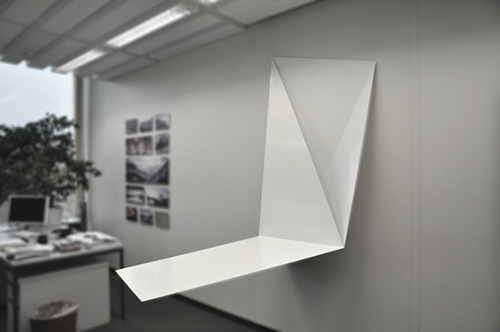|
|
Design: Özgür Keles and Pierluigi DʼAcunto
Collaborator: Simon Wolfensberger
Manufacturing: Gebr. Gysi AG, Baar
The design of an office desk out of a folded steel plate has been used as a case study to explore the opportunities of folding as a formal method for structural design. Folding represents a powerful technique to consistently integrate architectural and structural thinking within the design process, starting from the early conceptual stages.
The project foldDESK is an attempt to redefine the traditional office desk typology by proposing an integrated solution characterized by the combination of diverse elements, namely a table top, a blackboard and a bookshelf, within the same unique system. Due to the spatial constraints of the site, a design solution has been proposed such that the desk, deprived of the conventional supporting legs, cantilevers directly from the wall. The clean and neat design of the desk directly relies on the potentials of folding to transform the necessity for load-bearing into the freedom of architectural expression. In particular, the cantilevering desk gains its stability and structural stiffness thanks to the folded geometry of the steel plate, which has been designed to address at the same time the various programmatic requests.
The project builds on the interplay of the spatial and mechanical properties of folding. That is, a direct correlation can be defined between the internal force flow and the form of the load-bearing structure. The pattern of stress distribution in a folded structure can be well represented by a distribution of the internal forces along the fold lines. A pattern that can be described by a compression-and-tension truss model constituted by the edges of the folded structure. A parametric digital tool has been developed in order to design the folded desk. The tool builds on the compression-and-tension truss representation of the folded structure and relies on three-dimensional graphic statics. The tool is free of scale and material-independent, and allows for the geometry of the folded structure to be interactively modified while giving a direct feedback on the distribution of tensile and compressive internal forces. In this way, formal and structural questions can be simultaneously addressed during the design process.
High-tech manufacturing methods combined with the meticulousness of handcrafted fabrication techniques has allowed for the final full-scale desk prototype to be built. The desk is folded out of a 3mm-thick steel plate and it is welded on three edges.
Collaborator: Simon Wolfensberger
Manufacturing: Gebr. Gysi AG, Baar
The design of an office desk out of a folded steel plate has been used as a case study to explore the opportunities of folding as a formal method for structural design. Folding represents a powerful technique to consistently integrate architectural and structural thinking within the design process, starting from the early conceptual stages.
The project foldDESK is an attempt to redefine the traditional office desk typology by proposing an integrated solution characterized by the combination of diverse elements, namely a table top, a blackboard and a bookshelf, within the same unique system. Due to the spatial constraints of the site, a design solution has been proposed such that the desk, deprived of the conventional supporting legs, cantilevers directly from the wall. The clean and neat design of the desk directly relies on the potentials of folding to transform the necessity for load-bearing into the freedom of architectural expression. In particular, the cantilevering desk gains its stability and structural stiffness thanks to the folded geometry of the steel plate, which has been designed to address at the same time the various programmatic requests.
The project builds on the interplay of the spatial and mechanical properties of folding. That is, a direct correlation can be defined between the internal force flow and the form of the load-bearing structure. The pattern of stress distribution in a folded structure can be well represented by a distribution of the internal forces along the fold lines. A pattern that can be described by a compression-and-tension truss model constituted by the edges of the folded structure. A parametric digital tool has been developed in order to design the folded desk. The tool builds on the compression-and-tension truss representation of the folded structure and relies on three-dimensional graphic statics. The tool is free of scale and material-independent, and allows for the geometry of the folded structure to be interactively modified while giving a direct feedback on the distribution of tensile and compressive internal forces. In this way, formal and structural questions can be simultaneously addressed during the design process.
High-tech manufacturing methods combined with the meticulousness of handcrafted fabrication techniques has allowed for the final full-scale desk prototype to be built. The desk is folded out of a 3mm-thick steel plate and it is welded on three edges.
last modified 30.10.2015
